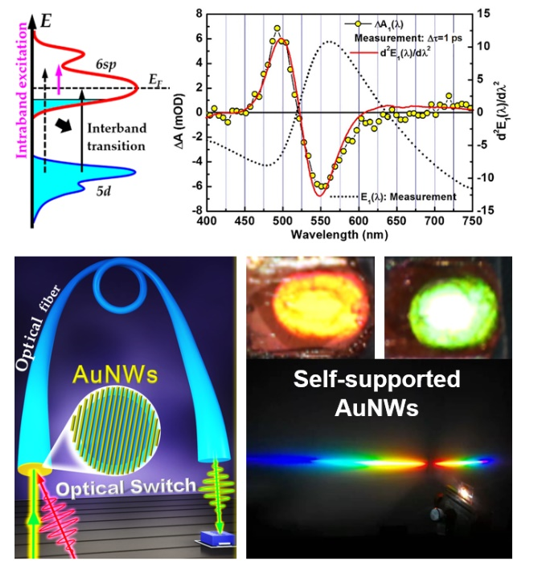Graphical Abstract

Abstract
Ultrafast optical spectroscopic response of plasmonic nanostructures can be utilized to achieve optical modulation devices, i.e., ultrafast optical switches. This is based on the ultrafast dynamics of the plasmonic electrons or collective oscillation of the free electrons in nanostructured metals. There are generally multifold electronic processes that are overlapped together, so that the ultrafast optical dynamics involves interactions between different processes with different time scales. Some of these processes are still not clearly understood, so that the observed optical signals produced during excitation by femtosecond laser pulses are most attributed to the plasmonic electron-electron or electron-phonon scattering processes. However, we discovered that the modulation on the energy band structures in the metal atoms by the femtosecond laser excitation is a nonnegligible mechanism, which is always accompanying the ultrafast electronic processes in metals and is even stronger than the plasmonic electronic interactions. Strong optical excitation by femtosecond laser pulses induce transient intraband transitions for the conduction-band electrons, producing a transient depletion layer underneath the Fermi level. This is equivalent to the lowering of the Fermi level, so that the threshold for interband transitions is lowered or red-shifted, producing a new transient absorption spectrum about the threshold wavelength (falling edge of the absorption spectrum) for interband transitions. Meanwhile, the plasmon band is pushed forward to the red, so that the plasmon-scattering induced optical extinction is reduced on the shorter-wavelength edge (rising edge) of the plasmon resonance spectrum, producing a new transient spectrum of enhanced transmission. These two features are just located on both sides of the threshold wavelength for interband transitions. Such a mechanism can be utilized to achieve ultrafast optical modulation and ultrafast optical switching devices. We achieved such optical switching devices by self-supported ultrathin films of gold nanowire gratings and by the integration of these structures onto the end facet of an optical fibre, so that the optical modulation signal can be sent to the other end of the fibre over a long distance.
Keywords
Ultrafast optical modulation; flexible plasmonic structures; band structure modulation; intra- and inter-band transition; optical fibre end integration.
Acknowledgement
The author acknowledges the National Natural Science Foundation of China (61735002, 12074020) and the Beijing Municipal Commission of Education (KZ202010005002) for the support.
References
- J. Yang, Y. Fu, X. Zhang, Nanoscale Advances 2022, 4, 943-951.
- X. Zhang, Nanophotonics 2021, 10, 1329-1335.
- J. Yang, X. Zhang, Advanced Science 2021, 8, 2100280.
- X. Zhang, M. Wang, F. Tang, H. Zhang, Y. Fu, D. Liu, X. Song, Advanced Science 2020, 7, 1902408.
Biography
Xinping Zhang obtained his PhD degree on 22 Oct 2002 at the Department of Physics, University of Marburg, Germany. He worked as an assistant of Prof. Harald Giessen at the Institute of Applied Physics, University of Bonn, Germany from 2003 to 2004. Then, he moved to Optoelectronics Group at Cavendish Laboratory, University of Cambridge, UK and worked as a research associate under the supervision of Prof. Sir Richard Friend from 2004 to 2006. Since Dec. 2006, Xinping Zhang has been a professor at College of Applied Sciences, Beijing University of Technology (BJUT). He is now a chair professor of Physics and Optical Engineering at Faculty of Science of BJUT. He is leading the Institute of Information Photonics Technology at BJUT. His research interests include Ultrafast Laser Technology, Ultrafast Spectroscopy, Nanophotonics, and Organic Optoelectronics. He has more than 200 published scientific papers.
Video Proceedings of Advanced Materials

Upcoming Congress



